MEMORIES
AND INFORMATION - STAFFS HOME GUARD
22nd STAFFORDSHIRE (WOLVERHAMPTON) BATTN.
and
2/LT. JOHN H. PENROSE
This
is a page within the www.staffshomeguard.co.uk website.
To
see full contents, go to SITE
MAP.
|
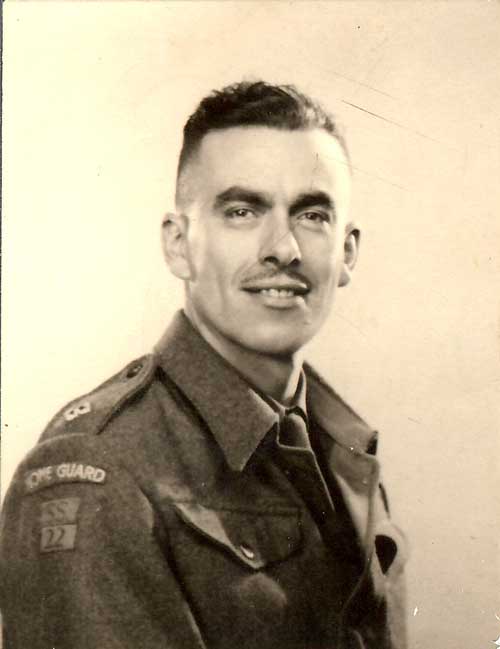 John Henry Penrose (1912-1993) lived with his wife Irene at 41 Lodge Road, Oxley from the time of his marriage in 1937 until the end of his life.
John Henry Penrose (1912-1993) lived with his wife Irene at 41 Lodge Road, Oxley from the time of his marriage in 1937 until the end of his life.
The early days of WW2 saw him acting as a voluntary ambulance driver in the worst of the 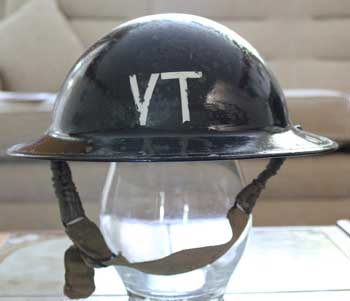 Birmingham Blitz of 1940 and 1941, an experience he would never talk about in later life. His Voluntary Transport helmet survives as a family treasure.
Birmingham Blitz of 1940 and 1941, an experience he would never talk about in later life. His Voluntary Transport helmet survives as a family treasure.
When war broke out John was working at Guy Motors in Wolverhampton whose wartime activities included the manufacture of tanks. (There a process of butt-welding steel plate was developed - obviating the need for riveting in tank production). In 1941 he joined
Marston Excelsior Ltd., a subsidiary company of ICI Ltd. and located near to Oxley on the northern edge of the town of Wolverhampton; he would work there until his retirement in 1974. Marston Excelsior (later known as IMI Marston and still operating in 2013 as HS Marston) was moving its major operations out of its Paul Street premises to a new site at
Fordhouses although production continued at Paul Street as well. By that time such activities as the manufacture of the Sunbeam motorcycle had been disposed of several years previously and the Company was heavily invoved in the manufacture of components for the aircraft industry. Amongst the many products were heat exchangers of different kinds, such as radiators and oil coolers; and fabricated aircraft fuel tanks where the technology was rapidly evolving into something quite different: the production of flexible tanks in rubber, often self-sealing (and sometimes erroneously described as "bullet-proof"). John's work at the time
was at Paul Street where he was a Tool Designer. Only much later did he move to the new Fordhouses site.
On September 18th 1941 - and possibly not long after joining the Company - John volunteered to serve in the local Home Guard, the
22nd Staffordshire (Wolverhampton) Battalion whose C.O. at that time was
Lt.-Col. A.F.R. Godfrey (a Great War Lieutenant in the Dorset Regiment) and, later,
Lt.-Col W.T.D. Morgan. John found himself in "D" Coy. of the Battalion. The Battalion H.Q. was at "Ellerslie", Riley Crescent, Wolverhampton. There are strong indications that "D" Coy. or one or more of its constituent platoons including No. 23 (to which John belonged) represented the Marston factory Home Guard unit which was manned solely by employees and charged with the responsibility of defending the sites. (All major manufacturing plants had their own HG unit at that time). Part of their responsibilty was also to guard the Boulton & Paul airfield which was nearby. Training exercises took place there, sometimes using snap-crackers to simulate gunfire; a post-war surplus of the latter in the Penrose family home led to an experiment in their use in home-made Christmas crackers - the result is unrecorded!
Training was intensive, in this and every other HG unit. Here is John's Proficiency Card.
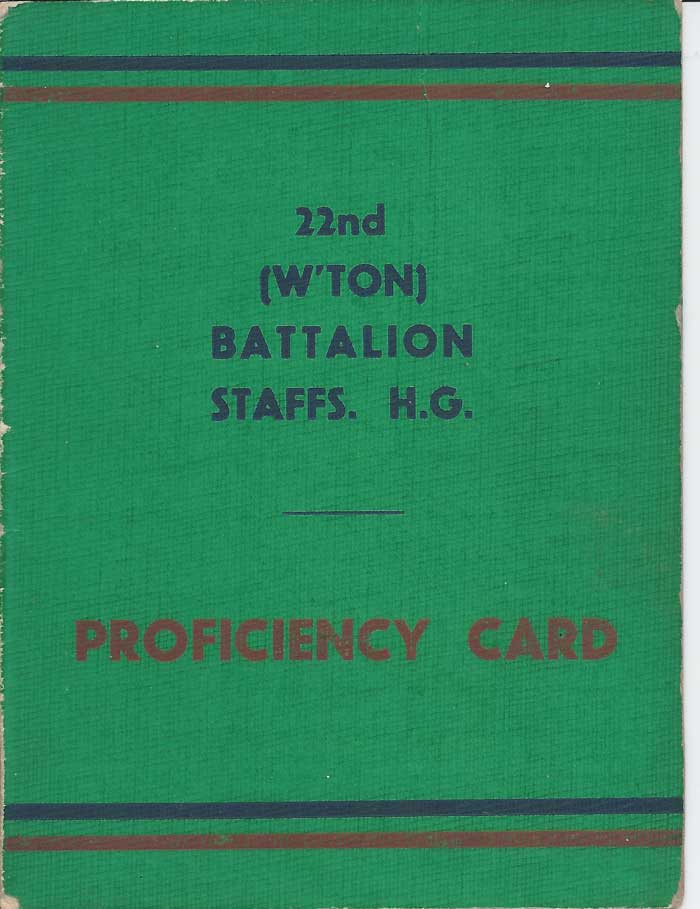
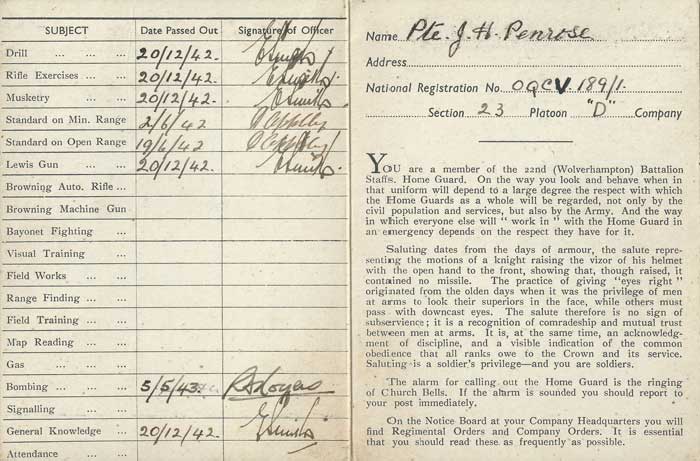
Can one detect the names of other Marston Excelsior employees amongst the signatories? Perhaps
R.A. Rogers,
E. (Ernie) Smith and
D. Appleby (a Second Lieutenant by 1941 and recipient of a Military Medal in the Great War).
In addition to the above qualifications (and it is surprising that the card suggests that he might not have been examined in other fields: this is unlikely to have been the case) John was issued with two training manuals, one entitled Manual of Guerilla Tactics and the other
Manual of Commando and Guerilla Warfare - Unarmed Combat. Click on these titles to see the blood-curdling contents. The existence of these documents in John's papers implies that they were part of the training which he received during his Home Guard service.
In the first desperate days of the Home Guard's existence the vast majority of Home Guard officers and NCOs had had Great War military experience, sometimes in positions of authority, sometimes as lowly privates. Such experience was regarded as essential and the only exceptions were younger men with specialist knowledge or ability of some kind. But as time went on suitable individuals were identified within the ranks and promoted. John Penrose was one of these: on June 9th 1943 he was appointed Second Lieutenant. He received a letter of congratulation from the Battalion C.O., Lt.-Col. Morgan:
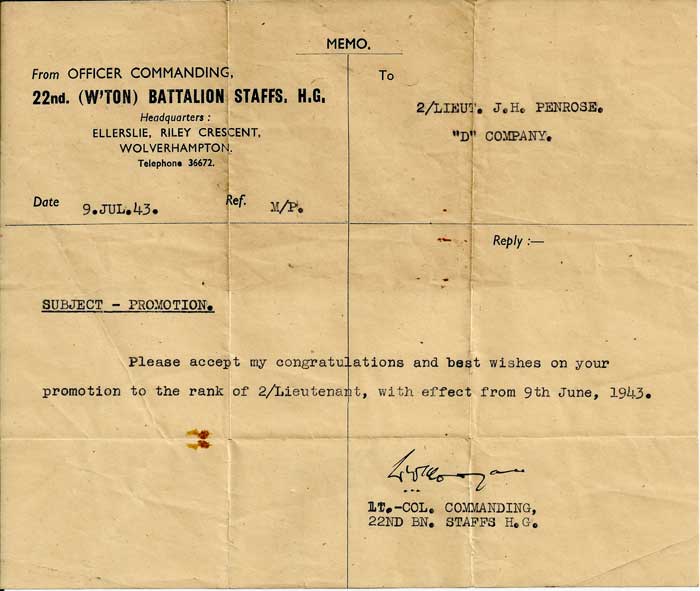
In the period leading up to his promotion John had been in a group undergoing special training. An photograph of that group was taken by the Express and Star newspaper and subsequently published, under the caption
Future W'ton HG Officers in Training. The group was wearing respirators whilst undertaking training for a gas attack; this, together with the poor quality of the image, makes the identification of John on it something of a challenge! The location of the training may have been Boulton-Paul's airfield at Pendeford.
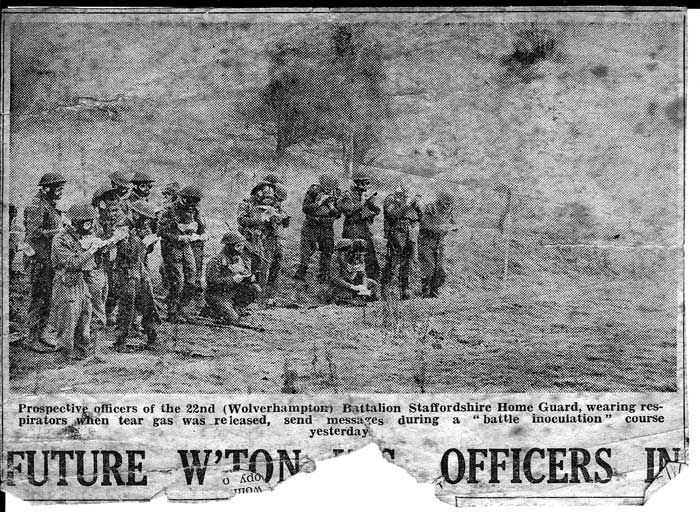
At some time after his commissioning, all the officers of the Battalion were photographed at an unknown Wolverhampton location (although it may have been outside either "Ellerslie" in Riley Crescent or Bantock House). The date was possibly November/December 1944 as the life of the Home Guard neared its end. John Penrose is standing on the extreme left.
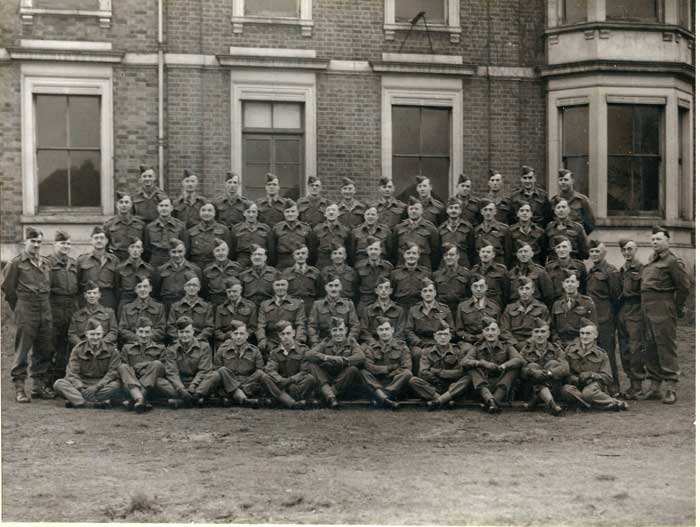 (To assist identification a magnified version of this image is available. Click on the image to view it).
(To assist identification a magnified version of this image is available. Click on the image to view it).
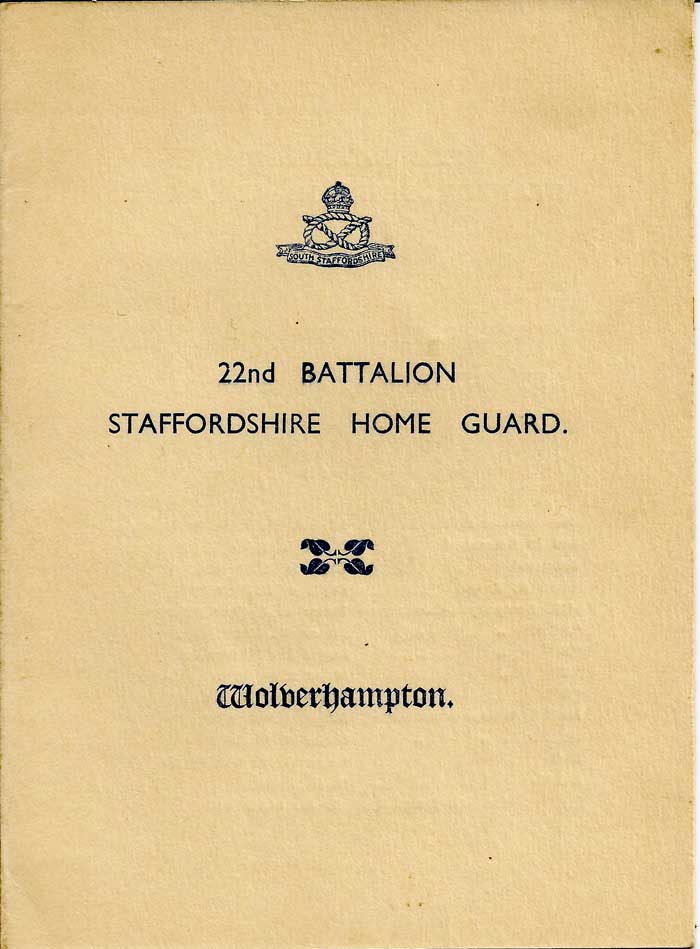
Eventually after four-an-a-half years of intensive voluntary effort, the need for the Home Guard dwindled as the German Army was forced back to its heartland and the threat of incursion or invasion in these isles finally disappeared. In late November 1944 the stand-down was announced.
On Sunday December 3rd 1944 every battalion throughout the country held its final parade. And a huge parade took place through Hyde Park in London, with representatives of every unit in the country marching past the King and Queen and the Princesses. There is a moving contemporary description of it
elsewhere in the website.
Stand-down was also marked in November 1944 by a message from Lt.-Col. Morgan to all members of the Battalion. John was of course a recipient and this is his copy. |
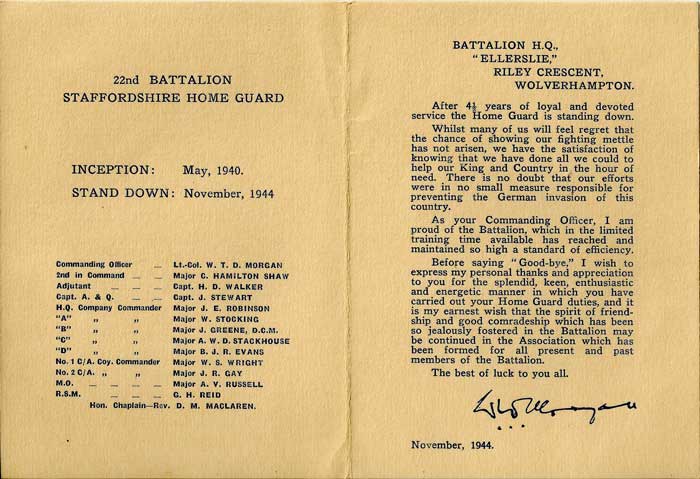 |
Members of "D" Coy. came together for a further celebration. A farewell dinner was held in the Marston Excelsior works canteen - one assumes at Fordhouses - on the evening of Saturday, December 16th 1944. John's programme survives.
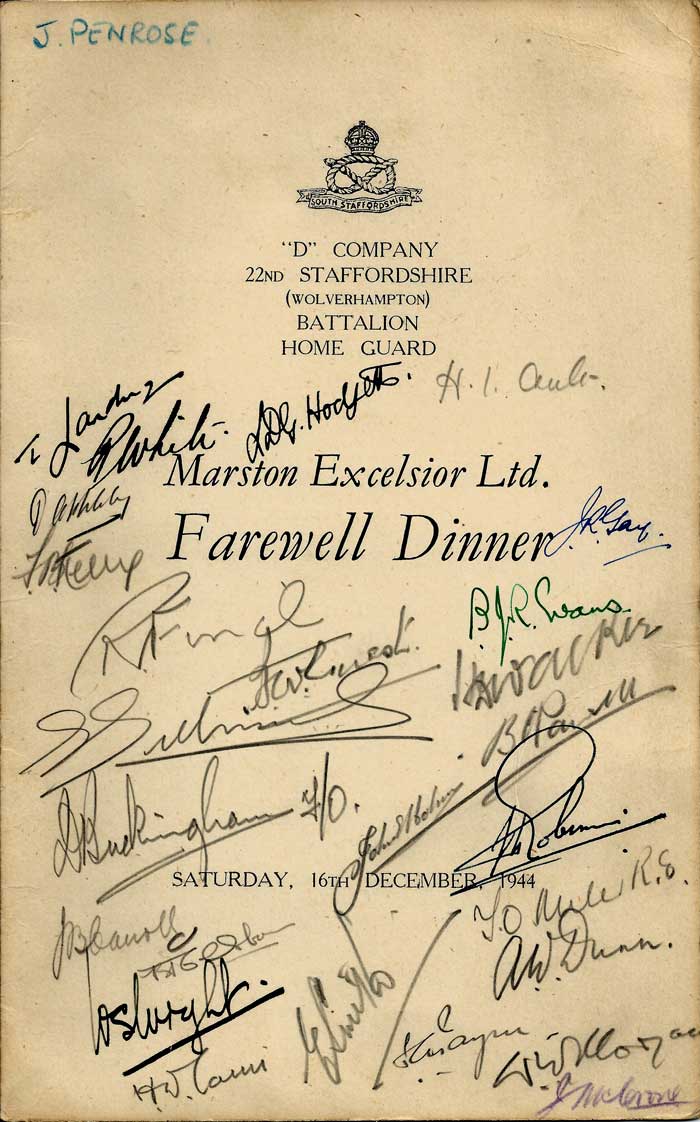
Amongst the decipherable signatories can be seen several serving members of the Marston unit including
D. Appleby, F.B. (Frank) Kelly and B.W. Guest. Other Marston people who may not have been members of the unit include
R. Finch,
E. (Ernie) Smith and A.W. (Alf) Dunn. Battalion officers include
Lt.-Col. W.T.D. Morgan (Battn. C.O.),
Major J.R. Gay
(No.1 C/A? Commander), Major B.J.R. Evans
("D" Coy. C.O.)
, Capt. H.D. Walker (Battn. Adjutant) and
Major J.S. Wright (No.2 C/A? Commander). Other names appearing include
R. White,
L.D.G. Hodgetts,
H.I. Gault,
D. Buckingham,
B. Powell,
John Holmes,
J.B. Carroll,
H.W. Cann, and
Argue(?); it is reasonable to assume that they were all H.G. members, either belonging to the Marston unit or "D" Coy. as a whole. Perhaps visitors to this website may be able to identify and place other names.
H.E. Jackson, whose name appears on the Toast List, was at the time Chairman or Managing Director of ICI Ltd. Metals Division at Witton, Birmingham.
Not appearing are the names of other Marston employees thought to have been members of the Marston unit at Fordhouses:
R.A. Rogers, (see above),
Harry O. Abel and George Peck.
In common with all long-serving members of the Home Guard, John Penrose received a certificate of appreciation from the King.
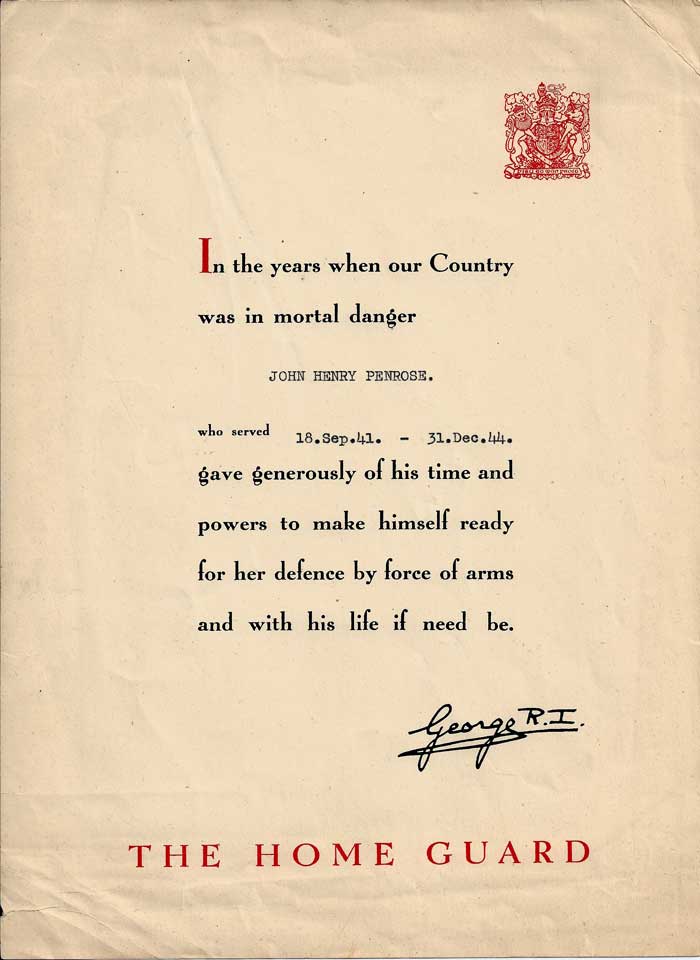
A great spirit of comradeship developed within many Home Guard units, fostered by shared adversity, mutual reliance, humour and the existence of a clear, unquestioned common cause. Groups of men were reluctant to see the dissolution of this bond and the result was the formation of Associations throughout the country. Sometimes these represented an opportunity to exercise newly acquired skills and Home Guard Rifle Clubs were the result: at least three of the Wolverhampton Battalions, the 21st, 22nd and 23rd, formed clubs of this type and these thrived, in one form or another for many years. Members of the 8th and 22nd later joined forces with others to form the 22/44 Club which is active to this day. Other Home Guard clubs were formed for purely social purposes.
The 22nd Wolverhampton Battalion was no exception. It formed The 22nd Battalion Staffordshire Home Guard Association (of which the Rifle Club may possibly have been a sub-section or it may have been wholly independent). John Penrose became a member.
The annual subscription was 2/6 (£0.125) and a Life Membership was available for two guineas (£2.10).
The objects were clearly stated: social, supportive and charitable.
Further pages cover the rules of membership in some detail.
These were the objects of the Association: |
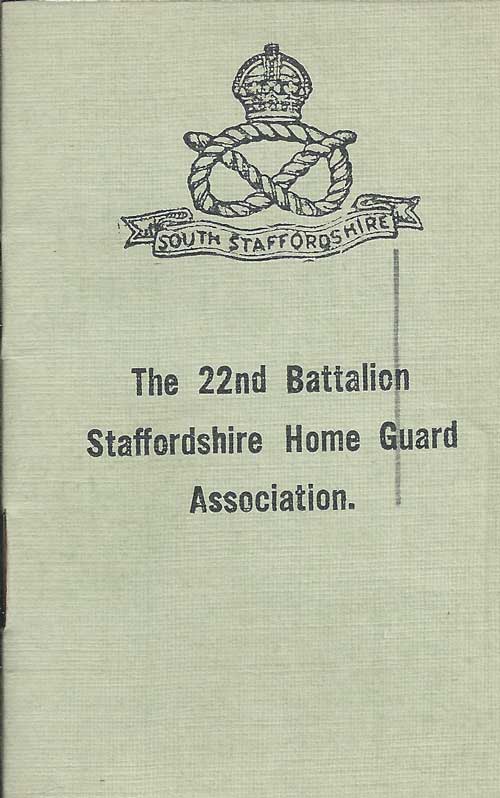 |
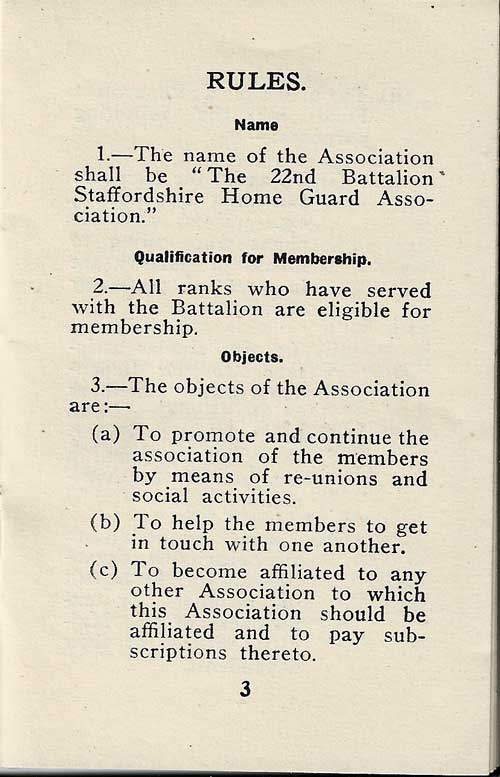 |
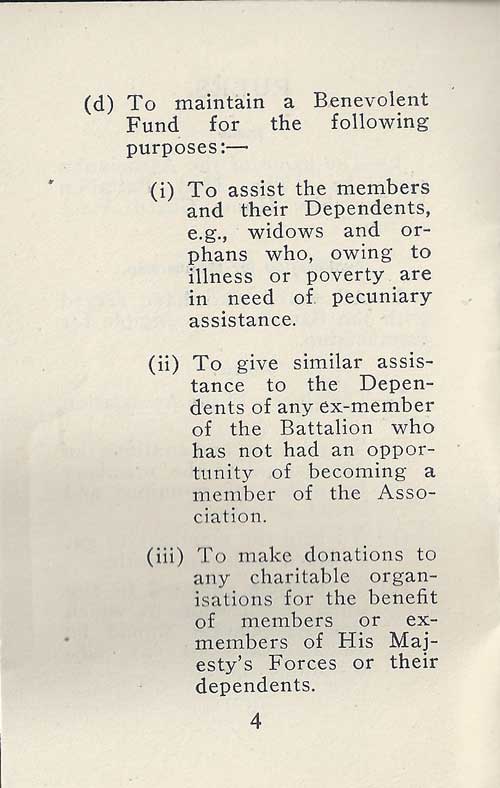 |
It is not known how long the Battalion Association survived and how successful it was in achieving its objects. At the very least it must have been the case that, by dint of daily contact at their place of work, members of the Marston unit continued to maintain a close working relationship. In so doing they would have withstood the general tendency of Home Guard members to drift apart as the civilian pressures of family and work reasserted themselves, individuals could once again pursue their own priorities and the memory of desperate days faced together in comradeship gradually faded.
In Memory of
2/Lt. John Penrose
and
of all his comrades
serving in
22nd Staffs (Wolverhampton) Battn.
and at
Marston Excelsior Ltd.
|
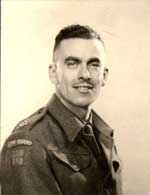 |
Two of the training manuals which were issued to John Penrose - and the blood-curdling contents of which he will have had to master - have survived and are reproduced elsewhere in this website:
Manual of Guerilla Tactics
Manual of Commando and Guerilla Warfare - Unarmed Combat
Further information
on this Battalion
Many of the men of the
22nd
Staffordshire (Wolverhampton) Battalion can
be seen in a number of magnified, high definition
photographs
on this
page of the website. Most of the officers are
identified and they include men of whom mention is made on
this page. Other pages are devoted to a member of the
Battalion band,
Pte. Jack Higgs; and to
Sgt. Geoff Hanley,
to whose service there was more than met the eye.
Acknowledgement
Grateful
acknowledgement is made to Mr Derek Penrose for providing this information about his father and generously permitting its publication.